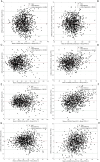Pulse rate variability is not the same as heart rate variability: findings from a large, diverse clinical population study
- PMID: 40809286
- PMCID: PMC12343505
- DOI: 10.3389/fphys.2025.1630032
Pulse rate variability is not the same as heart rate variability: findings from a large, diverse clinical population study
Abstract
Introduction: Scientists and consumer products are increasingly employing light-based photoplethysmography (PPG) instead of electrocardiography (ECG) assuming it accurately quantifies heart rate variability (HRV). Recent studies, however, have demonstrated that pulse rate variability (PRV) derived from PPG is not equivalent to HRV-derived from ECG. This study investigated the agreement between PPG-PRV and ECG-HRV in a beat-to-beat analysis in 931 adults recruited from a tertiary academic medical center in the southeastern United States.
Methods: Participants wore two (chest and bicep) Warfighter Monitor™ devices (Tiger Tech Solutions, Inc.). Heart rate (HR), pulse rate (PR) and three time-domain indices for PPG-PRV and ECG-HRV were measured. ECG-derived RR and noise-filtered NN intervals were extracted to compute HR, SDNN (standard deviation of NN intervals), rMSSD (root mean square of successive differences), and pNN50 (percentage of successive NN intervals differing by >50 ms). PPG-derived pulse-wave peaks were detected to calculate corresponding PR/PRV metrics. Pearson correlation, Bland-Altman, and one-way ANOVA analyses assessed linear association, bias, and mean differences across select chronic diseases.
Results: Significant disagreement and differences were observed between ECG-HRV and PPG-PRV (p < 0.001 for all). For rMSSD: cardiovascular: 3.04 ms, 95% CI: 1.33, 4.75, endocrine: 2.85 ms, 95% CI: 0.52, 5.18, and neurological: 4.39 ms, 95% CI: 1.39, 7.39). For SDNN: cardiovascular: 8.50 ms, 95% CI: 5.25, 11.74, endocrine: 8.43 ms, 95% CI: 3.97, 12.90, neurological: 11.84 ms, 95% CI: 6.02, 17.67, and respiratory: 7.23 ms, 95% CI: 1.83, 12.62). For pNN50: cardiovascular: 2.48%, 95% CI: 1.67, 3.3, endocrine: 2.21% 95% CI: 1.12, 3.29, neurological: 2.91%, 95% CI: 1.25, 4.32, and respiratory: 1.46%, 95% CI: 0.15, 2.77).
Discussion: PPG-PRV is a poor surrogate for ECG- HRV as it significantly underestimated SDNN, rMSSD, and pNN50 across select chronic diseases. Given the widespread use of PPG-based devices and ubiquitous, incorrect assumption that PRV accurately reflects HRV, researchers, clinicians, and manufacturers must clearly distinguish between PRV and HRV in studies and product claims.
Keywords: autonomic nervous system; cardiovascular; electrocardiogram; heart rate variability; pulse rate variability; pulse wave; technology; wearable.
Copyright © 2025 Kantrowitz, Ben-David, Morris, Wittels, Wishon, McDonald, Renaghan, Feigenbaum and Wittels.
Conflict of interest statement
Authors HW, MW, SM, and SW were employed by Tiger Tech Solutions, Inc. The remaining authors declare that the research was conducted in the absence of any commercial or financial relationships that could be construed as a potential conflict of interest.
Figures






Similar articles
-
Are Wearable Photoplethysmogram-Based Heart Rate Variability Measures Equivalent to Electrocardiogram? A Simulation Study.Sports Med. 2024 Nov;54(11):2927-2934. doi: 10.1007/s40279-024-02066-5. Epub 2024 Jun 27. Sports Med. 2024. PMID: 38935328
-
Impact of signal length and window size on heart rate variability and pulse rate variability metrics.Physiol Meas. 2025 Jul 17;46(7). doi: 10.1088/1361-6579/adece2. Physiol Meas. 2025. PMID: 40623427
-
Validation of Photoplethysmography Using a Mobile Phone Application for the Assessment of Heart Rate Variability in the Context of Heart Rate Variability-Biofeedback.Psychosom Med. 2023 Sep 1;85(7):568-576. doi: 10.1097/PSY.0000000000001236. Epub 2023 Jul 25. Psychosom Med. 2023. PMID: 37678565
-
Do Pain and Autonomic Regulation Share a Common Central Compensatory Pathway? A Meta-Analysis of HRV Metrics in Pain Trials.NeuroSci. 2025 Jul 5;6(3):62. doi: 10.3390/neurosci6030062. NeuroSci. 2025. PMID: 40700127 Free PMC article. Review.
-
Heart rate variability and myocardial infarction: systematic literature review and metanalysis.Eur Rev Med Pharmacol Sci. 2009 Jul-Aug;13(4):299-307. Eur Rev Med Pharmacol Sci. 2009. PMID: 19694345
References
-
- Ajdaraga E., Gusev M. (2017). Analysis of sampling frequency and resolution in ECG signals. In: 2017 25th telecommunication forum (TELFOR); 2017 November 21–22; Belgrade, Serbia: IEEE Xplore. p. 1–4. 10.1109/TELFOR.2017.8249438 - DOI
-
- Ajmal, Boonya-Ananta T., Rodriguez A. J., Du Le V. N., Ramella-Roman J. C. (2021). Monte carlo analysis of optical heart rate sensors in commercial wearables: the effect of skin tone and obesity on the photoplethysmography (PPG) signal. Biomed. Opt. Express 12, 7445–7457. 10.1364/BOE.439893 - DOI - PMC - PubMed
LinkOut - more resources
Full Text Sources
Research Materials

